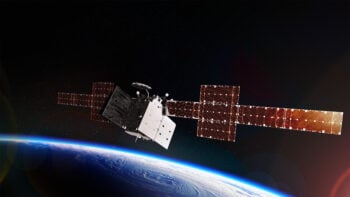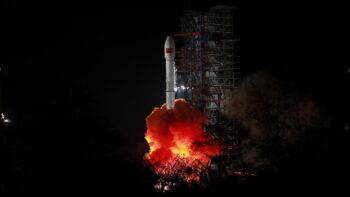
WASHINGTON — As senior Space Force officials double down on their campaign to massively increase the service’s funding ahead of decision-making on the Pentagon’s fiscal 2026 budget request, a handful of priorities are at the top of the list for new monies. These include alternatives to GPS, more reliable satellite communications (SATCOM), and improved intelligence, surveillance and reconnaissance (ISR) to support warfighters on the battlefield, according to the Space Force vice chief.
Citing ever-growing threats from China and Russia, Gen. Michael Guetlein told the Defense News conference on Wednesday that the service requires an influx of cash both to improve traditional space support services to combatant commanders, and bolster offensive and defensive capabilities to go up against adversary space systems.
“We need additional resources to meet the increasing demand for capability,” he said. “At 3 percent of the DoD budget, the Space Force is worth every penny. It offers tremendous value proposition for the nation. Every dollar invested brings asymmetric returns, while every cut risks asymmetric losses, given the continued advancements of the competitors, the Space Force budget needs more, not fewer, resources to do our job.”
Guetlein noted that Air Force Secretary Frank Kendall recently asserted (in an interview with Defense News) that the Space Force needs to “double or triple over time” its current annual budget of some $30 billion to adequately fund its assigned missions.
Kendall’s statement echoed a May assessment by veteran space budget analysts Todd Harrison of the American Enterprise Institute and Mike Tierney, chief of legislative affairs at the National Security Space Association (NSSA), which found that the Space Force’s eyes are bigger than its stomach. The service’s FY25 five-year budget plan, essentially a flat line, fails to fully support all the new acquisition programs being launched, the experts stressed.
Supporting The Joint Force
Guetlein said that in order to guarantee that “space capabilities will be there when needed” by military forces, the service needs to invest in both more SATCOM and “more resilient SATCOM” to ensure connectivity across the Joint Force.

“We know we need more satellite communications capacity, and we expect a significant increase in demand in the coming years and during times of crisis or conflict. The additional capacity will come from domestic investments in organic SATCOM like the Wideband Global SATCOM system and the Mobile User Objective Satellite system,” he said.
Increased bandwidth also “will come from commercial partnerships, like we’re doing through the Commercial SATCOM Office, and it will come from international partnerships like we have with Norway and with Luxembourg,” he added.
Guetlein further pointed to the Space Development Agency’s plan for a Transport Layer of low latency, high capacity data relay satellites in low Earth orbit as a critical future capability. “It is foundational to programs like the Combined Joint All Domain Command and Control System, or CJADC2, which is a multidomain command and control system that shares command, common operating pictures and data with the Joint Force and our allies,” he said.
More “resilient position, navigation and timing” capabilities, including “alternative methods to GPS,” are another key area of operations where an influx of funds is required, Guetlein stressed. He explained that the Space Force has already started “studies and low level effort on what we call Resilient GPS,” via Kendall’s “quick start” initiative. With $100 million approved by Congress as part of the FY24 National Defense Authorization Act, the initiative was designed to speed critical acquisitions by getting around constraints of the cumbersome budget process.
The Space Force in June released a request for proposal for the Resilient GPS effort to develop small satellites to complement the current 31 Global Positioning System satellites on orbit to members of the Space Enterprise Consortium (SpEC). Details of the RFP are restricted to consortium members, but an earlier request for information to industry stressed that the new prototype satellites should also be able to integrate into current ground systems. Space News on June 25 reported that Space Systems Command some time this fall plans to select up to five R-GPS design concepts that include the ability to signals for both civil and military use, plus the jam-resistant M-code.
However, the service is “waiting on the ’25 budget on the Hill to see where that kind of shakes out,” Guetlein said.
The Space Force further needs to invest in expanded “intelligence, surveillance and reconnaissance,” he added. The service has already launched a new satellite development program with the National Reconnaissance Office to track moving targets on the ground, and Guetlein noted that it is studying how to track airborne targets from space — with a goal of getting both capabilities to the field sometime in the early 2030s.
‘Protect And Defend’
“In addition, we are focused on preventing the adversary from using space against us,” Guetlein said.
He explained that the service continues “to invest in the kit to counter these [adversary] kill webs in three primary areas: enhanced [space domain] awareness to eliminate operational surprise; increased SATCOM to enable our own kill webs and support the joint warfighter; and in protecting and defending our space capabilities in order to eliminate the first mover advantage, and if necessary, to defeat their kill webs.”
However, with regard to defeating enemy systems, Guetlein said that “most of this kit is classified.”

He elaborated that the protect and defense mission includes “building defense measures into our next generation platforms, disaggregating capabilities to eliminate single points of failure, and proliferating capabilities across multiple orbits and platforms to significantly expand their attack surface. It also includes partnering with our allies and with industry to share threat data.”
Improved SATCOM, moving target indication, and reliable GPS also will play a role in helping the Space Force and Joint Force counter adversary space systems and prevent them from targeting US forces using those assets, he added.
“We are hard at work to avoid operational surprise and to ensure our adversaries cannot achieve first mover advantage in space,” he said.
Guetlein acknowledged that budget trends, especially on Capitol Hill, are not looking favorable for a major top-line hike for any of the services, stressing that the Space Force is honing in on its top priorities.
“We are definitely sacrificing some because there’s definitely not enough resources to go around,” he said. “We know we can’t buy everything we need, so we are ruthlessly prioritizing all the kit that we’re buying to make sure that it’s the biggest bang for the buck, if you will, during times of crisis or conflict.”

